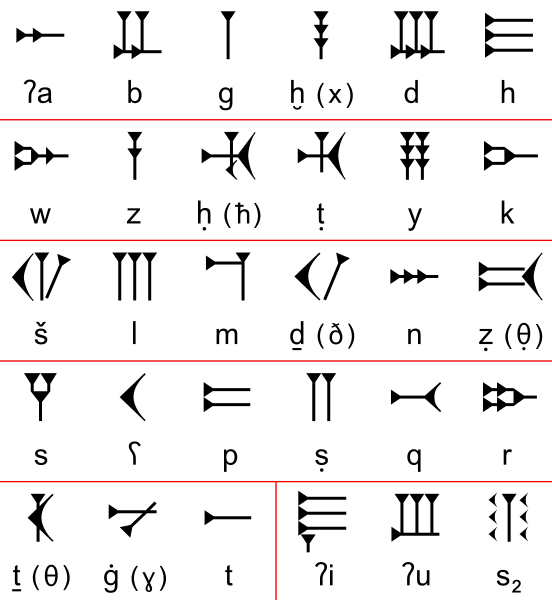Ficheru:Ugaritic-alphabet-chart.svg

Tamañu de la vista previa PNG d'esti ficheru SVG: 552 × 600 pixels. Otres resoluciones: 221 × 240 pixels | 442 × 480 pixels | 707 × 768 pixels | 942 × 1024 pixels | 1884 × 2048 pixels | 622 × 676 pixels.
Ficheru orixinal (ficheru SVG, 622 × 676 píxels nominales, tamañu de ficheru: 28 kB)
Historial del ficheru
Calca nuna fecha/hora pa ver el ficheru como taba daquella.
| Data/Hora | Miniatura | Dimensiones | Usuariu | Comentariu | |
|---|---|---|---|---|---|
| actual | 14:23 13 mar 2012 |  | 622 × 676 (28 kB) | AnonMoos | tweaking crossbar of ħ |
| 01:13 9 mar 2012 |  | 622 × 676 (28 kB) | AnonMoos | Table of letters of the Ugaritic cuneiform alphabet, with a conventional transcription. Where the "Semitological" symbols are somewhat divergent from the IPA symbol for the letter's probable pronunciation, the I... |
Usu del ficheru
La páxina siguiente usa esti ficheru:
Usu global del ficheru
Estes otres wikis usen esti ficheru:
- Usu en af.wikipedia.org
- Usu en am.wikipedia.org
- Usu en ar.wikipedia.org
- Usu en be.wikipedia.org
- Usu en bg.wikipedia.org
- Usu en ca.wikipedia.org
- Usu en de.wikipedia.org
- Usu en el.wikipedia.org
- Usu en en.wikipedia.org
- Usu en en.wiktionary.org
- Usu en eo.wikipedia.org
- Usu en es.wikipedia.org
- Usu en fa.wikipedia.org
- Usu en fr.wikipedia.org
- Usu en gl.wikipedia.org
- Usu en got.wikipedia.org
- Usu en he.wikipedia.org
- Usu en id.wikipedia.org
- Usu en it.wikipedia.org
- Usu en ja.wikipedia.org
- Usu en kk.wikipedia.org
- Usu en ko.wikipedia.org
- Usu en lfn.wikipedia.org
- Usu en ml.wikipedia.org
- Usu en nl.wikipedia.org
- Usu en no.wikipedia.org
- Usu en pl.wikipedia.org
- Usu en ru.wikipedia.org
- Usu en rw.wikipedia.org
- Usu en sl.wikipedia.org
- Usu en sr.wikipedia.org
- Usu en sv.wikipedia.org
- Usu en th.wikipedia.org
- Usu en uk.wikipedia.org
- Usu en uz.wikipedia.org
- Usu en zh.wikipedia.org

